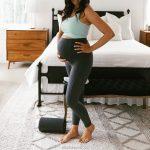Maternity Pants Size Chart And Fitting Guide
At some point during your pregnancy, you’ll stop attempting to fit into your usual clothing like your usual size trousers and start wearing maternity items such as maternity pants, maternity jeans, maternity leggings, maternity bras, maternity shirts, maternity tops, etc. Besides., odds are you’ll question why you waited so long to do it when it happened.
Maternity pants are made to complement and support a pregnant woman’s growing figure. So, there are some genuinely stylish alternatives available, so you don’t have to give up your style. A maternity pants chart will help you get the right one.
Maternity Fashion and Trends
Maternity fashion has developed significantly. Maternity clothing became available to ladies in the middle and higher sections of society who could afford it in the early 1900s. Maternity wear has become a component of many women’s pregnancies since then.
From the 1920s to the 1940s, maternity wear was primarily meant to hide women’s baby bumps while maintaining a feminine profile. Pregnant women accepted their changing bodies with new styles and trends in the 1950s and 1960s.
Maternity apparel of the 1980s and 1990s reflected popular fashions of the day, such as athletic wear and low-rise pants. Maternity clothes nowadays vary significantly from person to person and reflect a person’s particular style.
Maternity Pants Size Chart
So why is the maternity pants chart vital for pregnant ladies? The size chart is essential because it quickly helps you determine the size. This is why it is always important that you prioritize comfort to adapt your growing body while looking for the best maternity pants pair by using the maternity pants chart to choose your favorite belly panel type and optimal style.
The maternity pants chart below will get you started, but be sure to refer to the manufacturers’ charts for their custom figures.
| Maternity Pants Sizes | Waist | Hips | Length | |||
| INCHES | CM | INCHES | CM | INCHES | CM | |
| XS | 28-30 | 71-76 | 37-39 | 94-99 | 38 | 96.5 |
| S | 30-32 | 76-81 | 39-41 | 99-104 | 39 | 99 |
| M | 32-34 | 81-86 | 41-43 | 104-109 | 39.8 | 101 |
| L | 34-36 | 86-91 | 43-45 | 109-114 | 40.6 | 103 |
| XL | 36-38 | 91-96 | 45-47 | 114-119 | 41.3 | 105 |
| XXL | 38-40 | 96-101 | 47-49 | 119-124 | 42.1 | 107 |
The same rules apply to maternity sizes and standard clothing sizes. So, if you usually wear a size small, you will continue to wear a small pregnancy size. For numerical sizes, the same rule applies: if you were an eight before becoming pregnant, look for clothing in that size.
For pants, especially designer styles that are labeled by waist size, for example, 28-inch, you’ll still look for a pair in that size–but in a maternal version. Your waist is no longer 28 inches, but staying with your pre-pregnancy size makes it simpler to determine your current size.
Maternity Wear size conversion chart
With the measurements taken and converted to alfa sizes, you can easily convert maternity pants sizes into the below Pant sizes in UK, US, EU and much more sizing systems
| Size Chart | XXS | XS | S | M | L | XL | XXL |
| Australia | 6 | 8 | 10 | 12 | 14 | 16 | 18 |
| US | 2 | 4 | 6 | 8 | 10 | 12 | 14 |
| UK | 6 | 8 | 10 | 12 | 14 | 16 | 18 |
| EU | 32 | 34 | 36 | 38 | 40 | 42 | 44 |
| France | 34 | 36 | 38 | 40 | 42 | 44 | 46 |
| Italy | 38 | 40 | 42 | 44 | 46 | 48 | 50 |
| Japan | 5 | 7 | 9 | 11 | 13 | 15 | 17 |
Plus Size Maternity Pants size chart
| HIPS / UNDER BUMP MEASUREMENT | |
| L (16 – 18) | 42″ – 43″ |
| XL (18 – 20) | 46″ – 48″ |
| XXL (22 – 24) | 50″ – 52″ |
| XXXL (26 – 28) | 54″ – 58″ |
Maternity Pants Sizing Guide: Finding Accurate Measurements
It’s a great idea to take measurements of essential areas like your bust, hips, waist (e.g 93-108 waist inch), chest (e.g chest girth inch), foot length inch, leg length inch, snug measurement, hip measurement, etc, before shopping for pregnant pants. This kind of clothing measurements or garment measurement will help you a great deal at the time of buying. Remember to use the manufacturer’s measurement guide and don’t forget to buy nursing bras to help you feel more comfortable around your chest region while also providing back support as your cup size grows.
It is necessary that the above-mentioned areas’ measurements are accurate in order to be able to get the correct figures and use size charts efficiently. The same criteria can also apply to baby shower dresses.
How to measure
Here is a brief guide on how to get accurate measurements for the essential areas of your body that are critical when it comes to size.
Hips measurements
Measure from your ankle to your pubic bone where your trousers typically sit—this is critical when selecting maternity pants.
Waist measurements
Wrap the measuring tape over your baby bump’s broadest area and ead the size.
Low waist
Take a body diameter measurement below the bump.
High waist
Measure the circumference of your body above the bump.
Inseam measurement
Measure the length from the top of your inner thigh to the bottom of your ankle.
The inseam measurement is the length of the pants and might vary depending on the shoes you want to wear with them. If you wear flats, take your measurement right above the ankle.
Conclusion
Once again when shopping for maternity pants, you’ll discover that they are similar to usual pants. They usually have a simple belly panel or are more elastic to suit a changing shape. They are designed in such a way that they naturally accommodate the expected generous baby weight gain. Always be sure to make use of a maternity pants size guide like what we have just covered above. This is the only way to ensure that your maternity pants fit perfectly and are suitable for work or keeping you calm while working out.
It is our hope that you have gained some valuable tips that will go a long way to help you find the very best maternity pants in terms of size and fitting. Please feel free and most welcome to ask any questions you might have about maternity pants and don’t forget to help out your fellow moms to be by sharing this maternity pants chart and size guide across social media. Wishing you all the best in this rewarding journey.
Picture in this post by Mauricio Gutiérrez on Unsplash
Related Maternity Size Charts
- Breast Size During Pregnancy: What to Expect
- Gap Women Size Chart with Easy to Use Size Conversion and Fitting
- Maternity Clothes Size Chart And Sizing Guide
- Maternity Pants Size Chart And Fitting Guide
- Breast shield Sizing Guide – Choose The Right Size Nipple Shield
- Maternity Legging Size Chart And Fitting Guide
- Breastfeeding Bra Size Chart – find your nursing bra size
- Maternity Tank Top Size Chart And Sizing Guide









